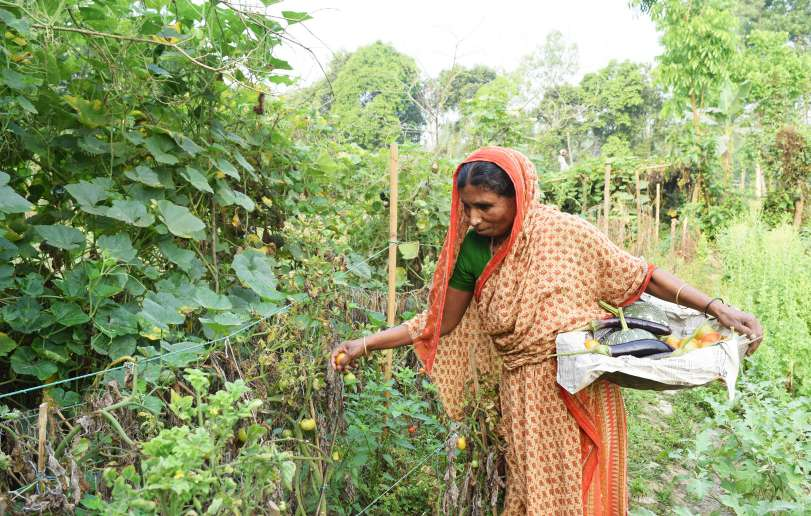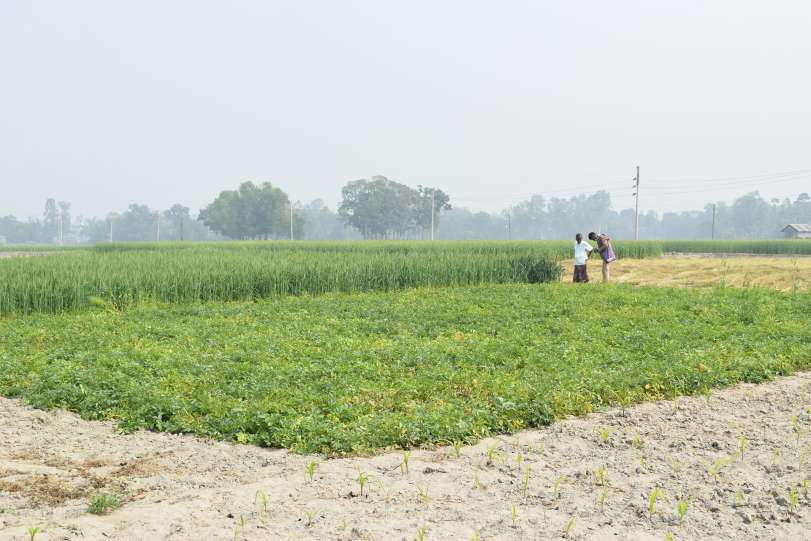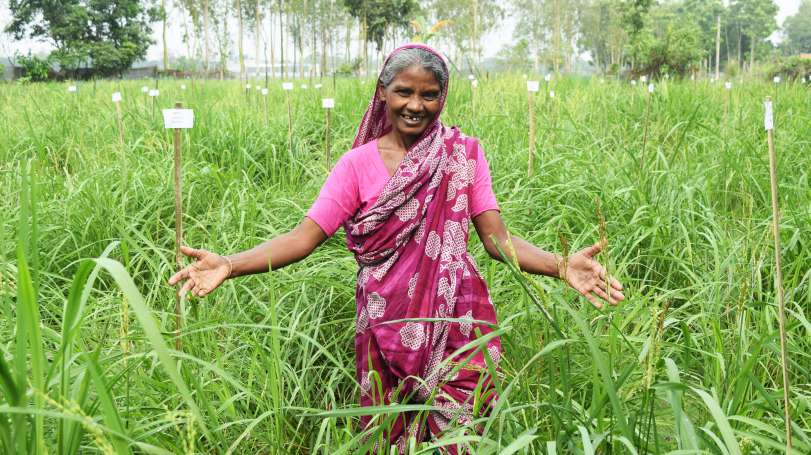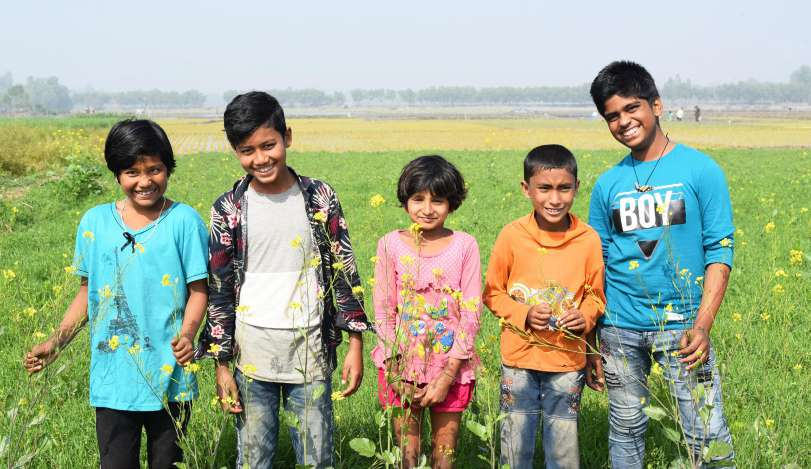Started in the early 1990’s, the Nayakrishi Andolon (New Agriculture Movement) has been building innovative farming practices based around ‘seed’. It is currently spread across 300,000 diverse member-households in Bangladesh.
| Authors | Farida Akhter; Farhad Mazhar |
|---|---|
| Topics | Agroecology |
| Case Report | Volume 1: "Resilience in the Face of COVID-19" |
Brief description
Bangladesh’s farmers have struggled for decades to market their produce and earn a decent living. In the 1960’s, farmers were persuaded to adopt the Green Revolution model of agriculture. As a result, their livelihoods and other subsistence needs have been increasingly threatened (Mazhar et. al., 2001). In fact, the trade policies within the neoliberal globalised economic system continue to favour the industrial sector over the agricultural sector (Akhter, 2020).
Started in the early 1990’s, the Nayakrishi Andolon (New Agriculture Movement) has been building innovative farming practices based around ‘seed’. It is currently spread across 3,00,000 diverse member-households in Bangladesh. Its objective is "to demonstrate the shohoj way to joyful living by ensuring biodiverse ecological regeneration of nature to receive food, fibre, fuelwood, medicine, clean water, and many different bio-material and spiritual needs of the community" (Mazhar, 2019). As Mazhar (2019) states, shohoj, in practice, explores the bio-spiritual potential of human communities in the real material world to transcend an oppressive, painful, and de-humanised existence.
Process that led to the community being resilient (Pre-covid)
According to Mazhar (2019), farmers are supposed to follow ten simple rules to be a Nayakrishi farmer. The first five rules are considered to be entry level, including clauses such as ‘absolutely no use of pesticide or any chemicals’ and ‘learning the art of producing soil through natural biological processes.’ The next five rules are integrated and advanced practices based on water conservation and organic maintenance of diverse farm species such as fish and poultry. As Mazhar (2019) puts it, "Developing integrated and complex ecological systems maximises systemic yield, contributes to innovating interesting ecological designs, and proves the immense economic potential of biodiversity-based ecological farming as a successful practical resistance against globalisation."
The Nayakrishi Andolon has built, among others, an institution called the Nayakrishi Seed Network (NSN) which is focused on in-situ and ex-situ conservation of seeds and biodiversity. The NSN works on three levels with the farming household as their focal point. First, the NSN is established in a village by Nayakrishi farmers who then ensure replantation, regeneration, and conservation of local species and varieties. Second, the Specialised Women Seed Network (SWSN) consists mostly of women who collect local seed varieties from different parts of Bangladesh, monitor and document the introduction of new varieties in a given area, and keep updated information of their assigned varieties. Lastly, the Community Seed Wealth (CSW) has been set up for the sharing and exchange of seeds and information between different entities such as villages, districts, and national institutions. All Nayakrishi farmers are free to collect seeds from CSW with the promise of returning twice the received amount after the harvest. The CSW has so far collected over 3,000 varieties of rice and 538 varieties of vegetables, oil, lentils and spices.
The Nayakrishi Andolon also encourages the growth of uncultivated food varieties, with low-income farmers collecting nearly 40 percent of their food and nutrition from uncultivated sources. These food sources are also important for medicinal purposes, both for people and animals (Mazhar, 2019). Functionally, Nayakrishi defines agriculture as the management of both cultivated and uncultivated spaces to ensure the maximum yield per acre of land—invigorating various ecological functions of the elements of living Nature.
How resilience that was established has helped during the pandemic
The COVID-19 pandemic brought markets and transportation to a halt in Bangladesh. Farmers were not able to travel for harvesting or selling their crops. Modern and conventional farmers who use harmful chemicals were hit especially hard. Since they take credits from dealers and are indebted, with the market being shut, they were unable to pay-off their debts.
According to Mazhar and Akhter (2020), although Nayakrishi farmers faced problems due to the market closures, they weren’t affected as badly. Since they practice mixed cropping, a number of their crops were already harvested when the pandemic affected Bangladesh’s markets, which they were able to sell off. Only the crops that were being grown and harvested during the lockdown weren’t sold. Additionally, the Nayakrishi farmers don’t have any debts from chemical fertiliser dealerships, so they haven’t had to pay-off any debts unlike conventional farmers.
Akhter (Mazhar and Akhter, 2020) talks about how the Nayakrishi farmers are selling their produce locally or exchanging and sharing produce among themselves as a community. For the next cropping season, they have their own collection of seeds whereas conventional farmers will have to buy seeds from the markets while also facing a cash shortage. The Nayakrishi farmers’ practice of little dependence on dominant markets and conventional chemical-based farming practices has largely helped them deal with this crisis. This is in sharp contrast to other farmers who are facing multiple issues—all of which are linked to their dependence on the (vulnerable) global market.
Jamal Hossain, aged 50, is a vegetable farmer with over an acre of land. Due to the lockdown, he couldn’t sell most of the produce—only selling some of it at a low price. Although his field was full of crops, transportation services were shut down and the local people had little cash. The market was open only for a short period every morning. So, he went to the market with the crops on a cycle. Still, he could not sell all his crops and sold some at half the price. He also distributed vegetables to his neighbours without charge. He has stored the cereal crops safely and hopes to sell them later for a better price.
Jamal has had to work harder because wage labour is not available. But, he feels sorry for commercial farmers using hybrid vegetable seeds which require fertilisers and pesticides. They couldn't buy those input materials as they didn’t have cash, the shops were closed and labour was not available. Jamal has used the seeds saved in the household, so he hasn’t had to go to the market and also isn’t dependent on fertilisers and pesticides.
An interesting aspect that the COVID-19 pandemic has brought to attention is bodily immunity. Comorbidities have been sharply highlighted, and the importance of having safe and nutritious food is slowly being realised. Though Nayakrishi farmers couldn’t buy food from the markets, they have been able to collect uncultivated food from their fields and surroundings, and therefore, they have nutritious food available which is free of harmful chemicals.
The Nayakrishi farmers’ agricultural produce such as rice, milk and vegetables have been seeing an increasing demand from urban consumers. These products are now being sold from the organic food shops Shashyaprabartana, as Nayakrishi continues to become a trusted name among city-based consumers.
Lessons learnt
Nayakrishi Andolon is showing the way for farmers’ resistance against a globalised food chain by using minimum external inputs, building on local knowledge, facilitating local markets, and practicing biodiverse agricultural techniques. They are showing that communities can achieve food sovereignty by being rooted to their soil and embodying ecological practices. The Nayakrishi way of bio-diverse agriculture has proved to be helpful in risk management during the COVID-19 pandemic. Their limited dependence on volatile corporate markets for agricultural inputs has been a key facet of their resilience. Finally, Nayakrishi Andolon is providing alternatives for safe, nutritious, and diverse food which is critical for well-being and survival during a global pandemic (Mazhar and Akhter, 2020).
Pathogens have always been abundant in nature. It is the capitalist practice of having little regard for ecological sustainability that continues to expose the human populace to such virulent disasters. COVID-19, with all the havoc it has wreaked, also presents an opportunity to shift away from destructive, chemical-based, and (exploitative) market-centred farming practices towards bio-diverse ecological agriculture.
References:
Mazhar, F. (2019). "Nayakrishi Andolon". Pluriverse: A Post-Development Dictionary. Ed: Kothari, A. et. al. New Delhi: Tulika Books.
Akhter. F (2020). "Nayakrishi Andolon shows Bangladeshi farmers the way forward" in South Asian Mirror. Accessed on 24-03-2021. https://southasianmonitor.net/en/sam-special/nayakrishi-andolan-shows-bangladeshi-farmers-the-way-forward
Mazhar. F., Akhter. F., Jony. J. A., Haque. R. (2001). "Nayakrishi andolon: Recreating community based organic farming". Leisa Magazine.
Mazhar, F. and Akhter, F. (2020). "A Response From Nayakrishi Andolon, A New Agricultural Movement in Bangladesh". Global Tapestry of Alternatives Webinar Series ‘Alternatives in the Times of Global Crises’.



